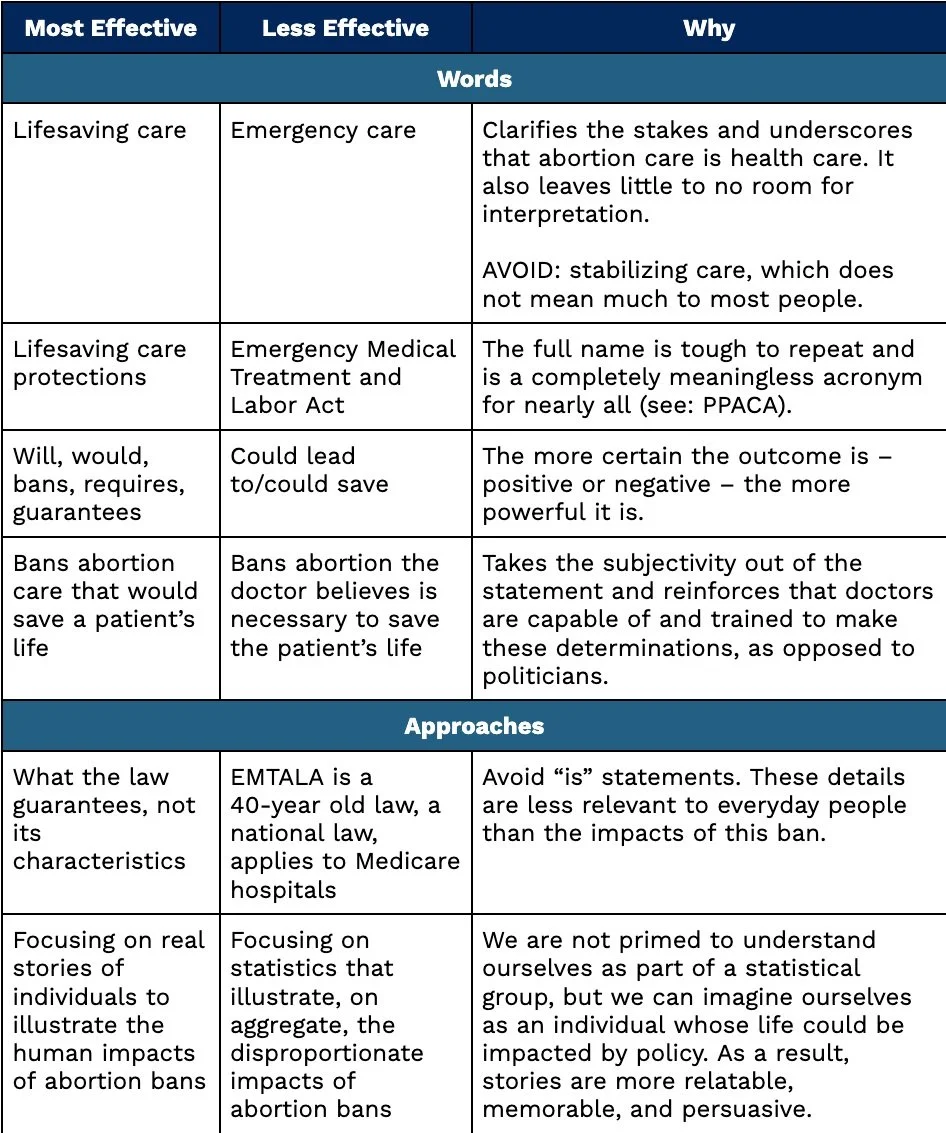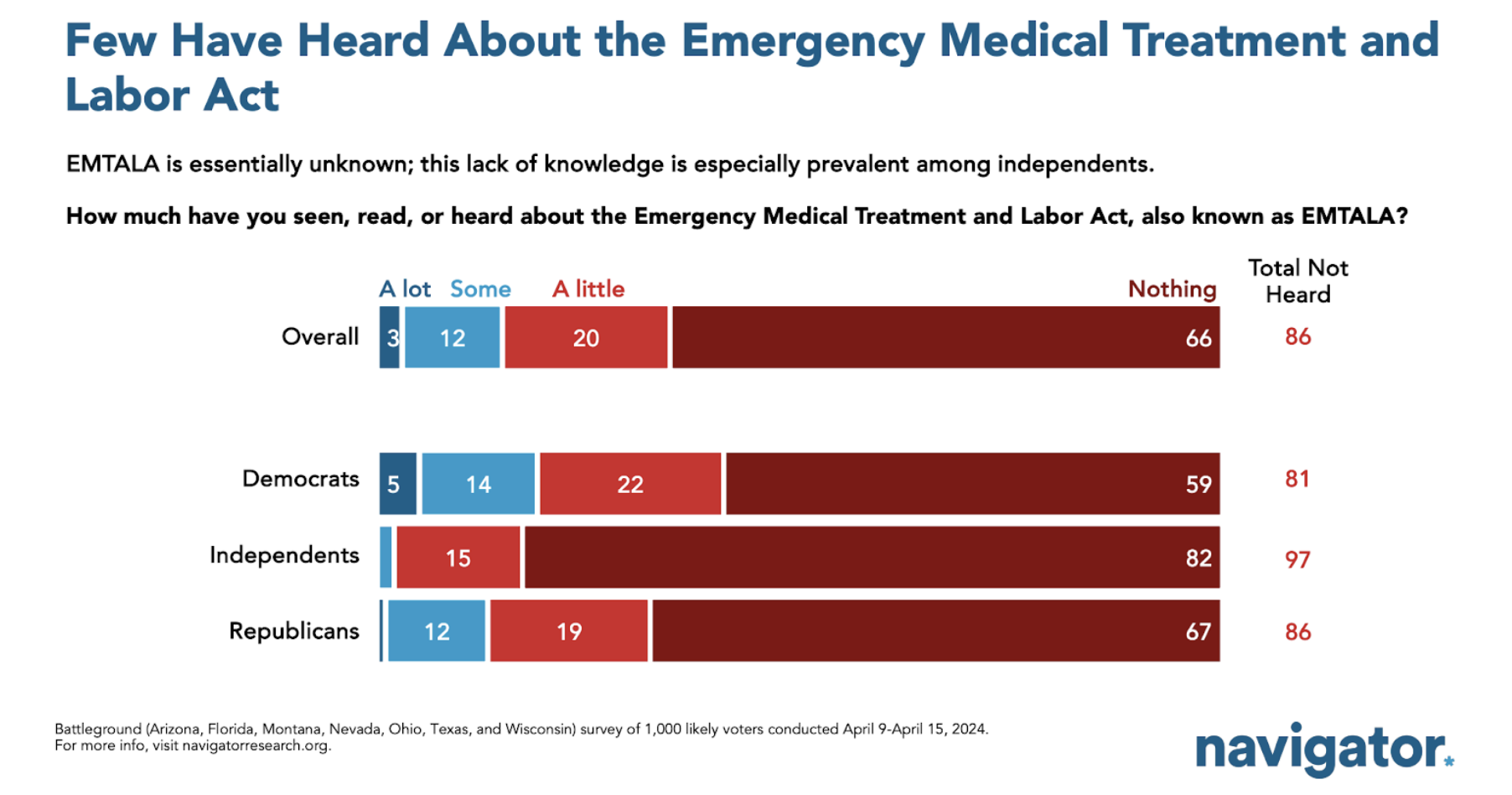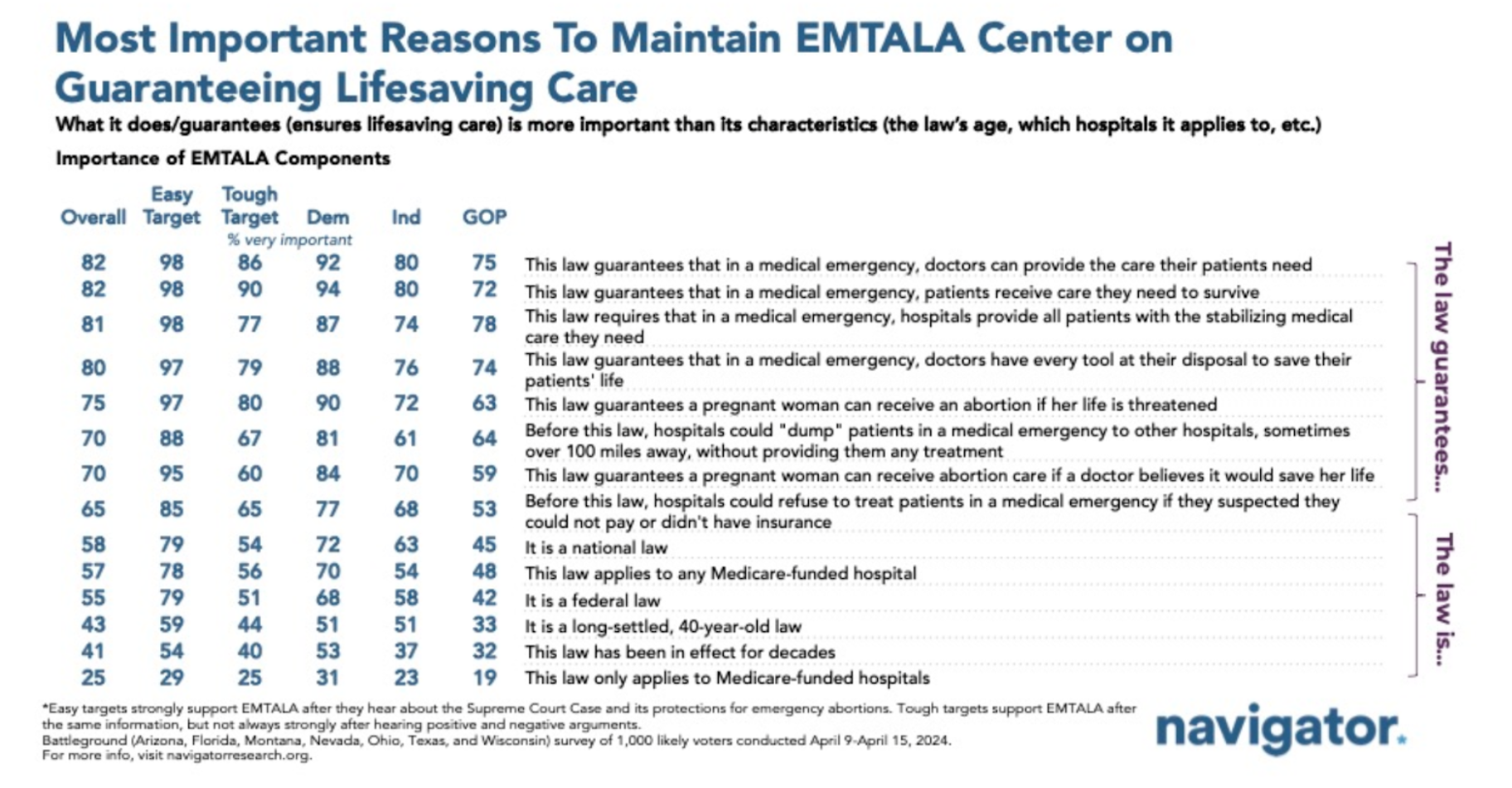Abortion Access | ADVOCATING FOR
lifesaving medical care
Contents
The Stakes
Strategic Goals and the Topline Messages to Advance Them
3 Tweaks to Make Your Advocacy More Effective
If You Post One Thing
Navigator Research Findings
The Stakes
For nearly 40 years, patients have been guaranteed that hospitals will treat them when they go to the emergency room in crisis – regardless of who they are or their insurance status. Now anti-abortion extremists are putting that guarantee at risk via an under-the-radar attack on abortion rights that is currently before the Supreme Court.
On Wednesday, April 24th, conservatives argued before the Court that national law – in this case, the Emergency Medical Treatment and Labor Act – is superseded by state-level abortion bans, and that when pregnant patients are facing life-threatening emergencies, hospitals are not required to treat them.
If the majority anti-abortion Supreme Court sides with anti-abortion extremists and removes guarantees of lifesaving medical care for patients it will have life or death consequences for Americans nationwide on an unprecedented scale. And given at least one-third of pregnant patients will go to the emergency room during their pregnancies those consequences can be seen at the macro- and micro-levels – and increasingly so in the post-Dobbs landscape. As one example of how this has played out in reality, only one patient was airlifted out of an Idaho hospital to receive emergency maternal care last year before this state-level law went into effect; in the months since this ruling went into effect in January, it has already happened six times.
Protecting abortion rights and expanding abortion access has never been more critical or more universally popular, uniting Americans of all race, gender, socio-economic status, geography, and political affiliation against the extreme, dangerous, anti-freedom agenda of Republicans in Congress. And we, as a progressive movement, have an opportunity to define the next fight on our terms.
But the protections for lifesaving medical care that the Supreme Court is considering taking away are largely unknown: Navigator Research found that only 15% of people had heard something about the Emergency Medical Treatment and Labor Act, but those protections for lifesaving medical care are overwhelmingly popular even after a simple description.
To put that into perspective, in March of 2024, 69% of Americans had heard a lot or some about the Alabama Supreme Court’s decision on IVF.
As progressive advocates go on offense to protect women’s freedoms and abortion access, it is critical that we do three things:
Concisely define this case on our terms and then pivot to the real life consequences for everyday people if anti-abortion advocates get their way.
Make sure messengers center patient narratives – especially if those messengers are emergency care physicians.
Be clear about the stakes by eliminating unnecessary uncertainty from our language.
Strategic Goals and the Topline Messages to Advance Them
GOAL: Concisely define this case on our terms and then pivot to the real life consequences for everyday people if anti-abortion advocates get their way
TOPLINE MESSAGE: This is about lifesaving medical care. This law guarantees that, in an emergency, patients receive the lifesaving care they need, including abortion care. But if the Supreme Court strikes down this law…
There is no guarantee that you or your loved one will receive the medical care you need in an emergency.
And in fact, a pregnant woman whose organs are shutting down due to a ruptured membrane will be denied the abortion care she needs to live. [Or another life-threatening, detailed, and vivid example of pregnant women facing serious medical emergencies].
Politicians will be in charge of whether women live or die.
GOAL: Make sure messengers center patient narratives – especially if those messengers are emergency care physicians.
TOPLINE MESSAGE: The consequences of banning lifesaving care have already created dire situations for too many Americans:
Last year in an Idaho hospital, only one patient needing life saving maternal care was airlifted out of state. In the months since this ruling went into effect in January, six patients have been airlifted from that same hospital.
A woman in Texas miscarried in a lobby bathroom of an emergency room after being denied medical care.
Pregnant women will be denied care, even if they are suffering from an ectopic pregnancy that threatens both their lives and future fertility, if their organs are shutting down due to a ruptured membrane, if they are miscarrying, etc…
A woman who is miscarrying will be forced to sit on the exam table, bleeding out profusely while doctors wait for the fetal heartbeat to stop before treating her.
Patients suffering from a medical emergency will be denied care because they can’t pay.
GOAL: Remove uncertainty from our language to be crystal clear about the stakes.
TOPLINE MESSAGE 1: This law guarantees that a pregnant woman can receive an abortion if her life is threatened.
Instead of … “if a doctor believes her life is threatened”
TOPLINE MESSAGE 2: If anti-abortion extremists get their way, pregnant women will be denied life-saving care.
Instead of … receive “delayed” care, or “limited” care
If You Post One Thing
The Supreme Court is hearing a case that could gut a national law guaranteeing patients, in an emergency, receive the lifesaving care they need, including abortion care. If anti-abortion extremists get their way, pregnant women will be denied life saving care.
If anti-abortion extremists get their way the Supreme Court will force doctors to deny pregnant women the lifesaving abortion care they need to survive
Navigator Research Findings
Please see here here here and here, as well as below for key Navigator Research findings on this Supreme Court case.





